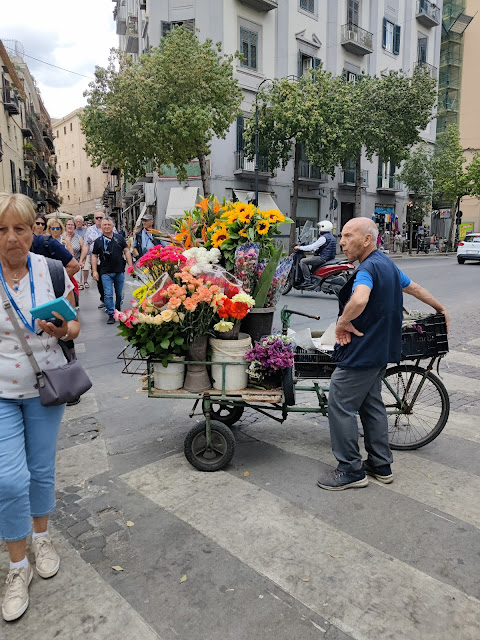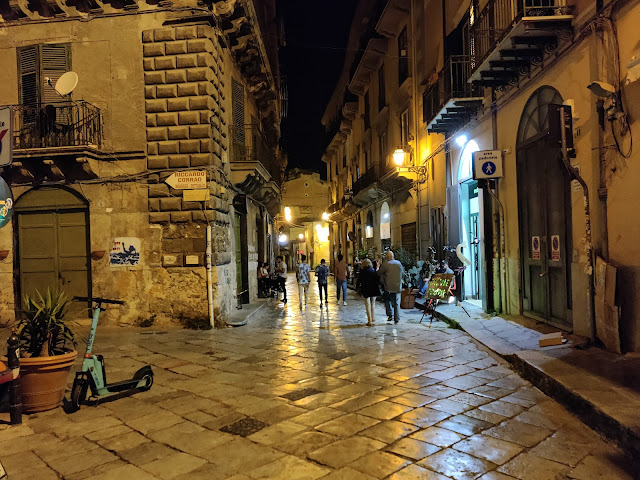We spent the first week of our trip in Palermo. Our Airbnb apartment was in the Kalsa district, near the port and also, it turned out, near pretty much everything we wanted to be near to. Lots of interesting bars, lots of important churches and museums, lots of places to eat, and the warm weather made being outside a pleasure day and night.
A lot of it could be a backdrop for a neorealist film noir, except that--at least in the neighborhood we were in--it didn't feel at all threatening.Here's a ruin that dates back to the Phoenicians, who founded settlements in what's now Palermo and in other parts of Sicily more than a thousand years ago. |
| Via Maqueda, a nightlife hot spot. |
The word that keeps coming to mind in Palermo is "gritty." It's not dirty or scary, at least not where we were. But it has a down-at-heels quality that keeps it from feeling like a theme park, even though most everyone seems to be having a great time. Many of the buildings look derelict, but like they've been derelict for the past several centuries.
This juxtaposition of an elegant palazzo and a place that looks like a squat is pretty typical.I enjoyed wandering around the city and gawking at everything. The place is so terrifically Italian, it seemed to me, perhaps because in the U.S. Sicilians are our idea of the prototypical Italians. There seemed to be something picturesque around every corner, like this flower seller downtown.
It wasn't unpleasantly hot, but much of the time the sky was hazy with dust blown over from Africa by the scirocco. You can see it hanging over this park alongside the port.
I noticed this gigantic banyan tree dominating a city park. Apparently it's a variety of fig that's native to Australia, but it seems to be thriving in Sicily.
I also spent an enjoyable couple of hours in the Modern Art Gallery of Palermo, which is housed in a former convent that was taken over by the civil authorities in the 1860s, in the wake of Italian unification. Despite its name, its collection is made up of very traditional work from the late 19th and early 20th centuries, including this large painting from 1898 by Pietro Pajetta.
It's titled Le gioie della famiglia, which at first I assumed must mean "the family jewels," because gioeilleria is the Italian for jewelry and what else explains the juxtaposition of the pantsless bambino and that carrot? But in fact it's "the joys of the family" that are being celebrated here, apparently including the thrill of a good carrot harvest.
Danny was considerably less enthralled with Palermo than I was, however. Where I saw the picturesque, he saw another noisy, crowded city. Where I saw neorealist romance, he saw piles of garbage.
 |
| I swear it was picked up by the next day. |
I also suspect some of his distaste was due to the omnipresence of churches, big, gaudy, overweening churches, all over the city. Much as I disapprove of the Catholic Church as an institution, I can't get enough of it as a living museum, the gaudier and gorier the better. And cheek by jowl with Palermo's battered buildings that look like unreconstructed casualties of World War II are churches, convents, and other expressions of the power that the Church wielded in Sicily over the centuries. Churches are everywhere in Italy, but in Palermo they seem even more ubiquitous and much more over-the-top.
This is Sant'Anna, a not particularly fancy church in our neighborhood. I never saw it open, so I'm not sure it's even still in business.
 |
| That's the Kalsa corner on the right. |
The architecture is less about glorifying God than asserting the dual power of the Church and whichever Great Power happened to be ruling Sicily at the time. Above is the Four Corners, the historic center of Palermo, a square with grandiose facades on all four sides of the intersection. On each corner is a statue of one of the four seasons on the bottom and of a patron saint of one of Palermo's four ancient districts on the top. Sandwiched in between them are statues of four Spanish kings who'd ruled over the island in the 1600s, when this Baroque fantasy was constructed.
But Spain was only the latest in a long line of external powers that controlled Sicily at one time or another, including Romans, Visigoths, Byzantine Greeks, the North African Fatimid Caliphate (at one point the island was majority Muslim), and the Normans. Traces of all those who came, conquered, and then lost out to some new conqueror are everywhere in Sicily.
Here, for example, is Palermo's cathedral, which is immense, like a shopping mall devoted to selling religion. The site was originally a Byzantine basilica, which Saracen invaders reportedly turned into a mosque. In the 1100s the Normans built a new church on the site, which was expanded and elaborated over the centuries. While the cathedral's layout is Norman, some of its early decorative stonework recalls North African designs.
Inside, a highlight is the overwrought silver urn containing the relics of Santa Rosalia, the patron saint of the city. Her remains are credited with miraculously saving Palermo from the plague in the 1600s, more than four centuries after the holy hermit died in a cave on nearby Mount Pellegrino. |
| Some hope Saint Rosalia can also save Sicily from Covid. |













1 comment:
Sorry, Danny, I think it's picturesque! Maybe after I'm more familiar with Italy as a whole I'll be less impressed. But probably not.
Post a Comment